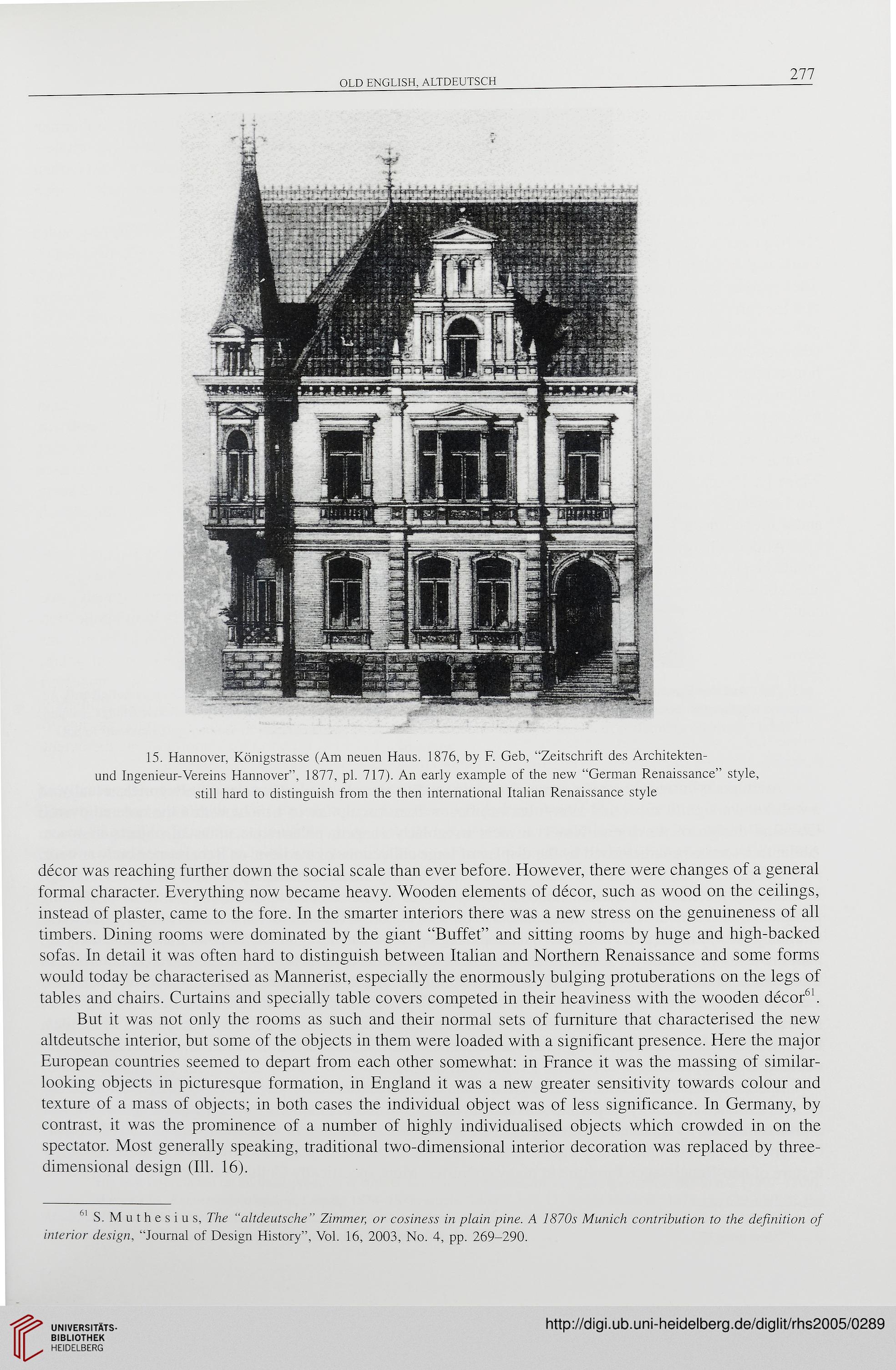OLD ENGLISH. ALTDEUTSCH
277
15. Hannover, Kônigstrasse (Am neuen Haus. 1876, by F. Geb, "Zeitschrift des Architekten-
und Ingénieur-Vereins Hannover", 1877, pl. 717). An early example of the new "German Renaissance" style,
still hard to distinguish from the then international Italian Renaissance style
décor was reaching further down the social scale than ever before. However, there were changes of a gênerai
formai character. Everything now became heavy. Wooden éléments of décor, such as wood on the ceilings,
instead of plaster, came to the fore. In the smarter interiors there was a new stress on the genuineness of ail
timbers. Dining rooms were dominated by the giant "Buffet" and sitting rooms by huge and high-backed
sofas. In détail it was often hard to distinguish between Italian and Northern Renaissance and some forms
would today be characterised as Mannerist, especially the enormously bulging protuberations on the legs of
tables and chairs. Curtains and specially table covers competed in their heaviness with the wooden décor61.
But it was not only the rooms as such and their normal sets of furniture that characterised the new
altdeutsche interior, but some of the objects in them were loaded with a significant présence. Here the major
European countries seemed to départ from each other somewhat: in France it was the massing of similar-
looking objects in picturesque formation, in England it was a new greater sensitivity towards colour and
texture of a mass of objects; in both cases the individual object was of less significance. In Germany, by
contrast, it was the prominence of a number of highly individualised objects which crowded in on the
spectator. Most generally speaking, traditional two-dimensional interior décoration was replaced by three-
dimensional design (111. 16).
S. M u t h e s i u s, The "altdeutsche" Zimmer, or cosiness in plain pine. A 1870s Munich contribution to the définition of
interior design, "Journal of Design History", Vol. 16, 2003, No. 4, pp. 269-290.
277
15. Hannover, Kônigstrasse (Am neuen Haus. 1876, by F. Geb, "Zeitschrift des Architekten-
und Ingénieur-Vereins Hannover", 1877, pl. 717). An early example of the new "German Renaissance" style,
still hard to distinguish from the then international Italian Renaissance style
décor was reaching further down the social scale than ever before. However, there were changes of a gênerai
formai character. Everything now became heavy. Wooden éléments of décor, such as wood on the ceilings,
instead of plaster, came to the fore. In the smarter interiors there was a new stress on the genuineness of ail
timbers. Dining rooms were dominated by the giant "Buffet" and sitting rooms by huge and high-backed
sofas. In détail it was often hard to distinguish between Italian and Northern Renaissance and some forms
would today be characterised as Mannerist, especially the enormously bulging protuberations on the legs of
tables and chairs. Curtains and specially table covers competed in their heaviness with the wooden décor61.
But it was not only the rooms as such and their normal sets of furniture that characterised the new
altdeutsche interior, but some of the objects in them were loaded with a significant présence. Here the major
European countries seemed to départ from each other somewhat: in France it was the massing of similar-
looking objects in picturesque formation, in England it was a new greater sensitivity towards colour and
texture of a mass of objects; in both cases the individual object was of less significance. In Germany, by
contrast, it was the prominence of a number of highly individualised objects which crowded in on the
spectator. Most generally speaking, traditional two-dimensional interior décoration was replaced by three-
dimensional design (111. 16).
S. M u t h e s i u s, The "altdeutsche" Zimmer, or cosiness in plain pine. A 1870s Munich contribution to the définition of
interior design, "Journal of Design History", Vol. 16, 2003, No. 4, pp. 269-290.




